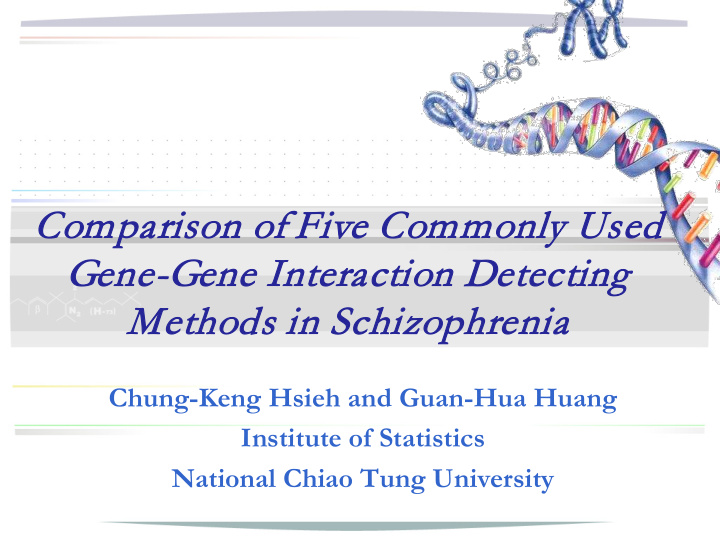



Com ompari rison on of of F Five C Commonly Used Ge Gene-Gene I Interaction Detecting Metho hods in S n Schi hizophr hrenia Chung-Keng Hsieh and Guan-Hua Huang Institute of Statistics National Chiao Tung University
Outline INTRODUCTION METHODOLOGY Study population Preliminary analyses Study design Methods Cross validation RESULTS CONCLUSION 06/26/2009 2
Outline INTRODUCTION METHODOLOGY Study population Preliminary analyses Study design Methods Cross validation RESULTS CONCLUSION 06/26/2009 3
INTRODUCTION Single-locus methods Gene-gene interaction SNP NP Genotype data Hap aplo lotype B e Block Haplotype data 06/26/2009 4
INTRODUCTION In the present study: Assessed the importance of gene-gene interactions on schizophrenia risk Data: 65 SNPs from 5 candidate genes 514 cases and 376 controls 06/26/2009 8
INTRODUCTION Five commonly used gene-gene interaction detecting methods Cross validation 06/26/2009 9
Outline INTRODUCTION METHODOLOGY Study population Preliminary analyses Study design Methods Cross validation RESULTS CONCLUSION 06/26/2009 10
Study population Schizophrenia dataset Data collection was based on TSLS program Genotyping of markers on 5 candidate genes: DISC1, NRG1, DAO, G72 and CACNG2 06/26/2009 11
Study population 514 schizophrenia cases and 376 controls Total 65 SNPs in five candidate genes 06/26/2009 12
Outline INTRODUCTION METHODOLOGY Study population Preliminary analyses Study design Methods Cross validation RESULTS CONCLUSION 06/26/2009 13
Preliminary analyses Data quality control: exclude SNP if HWE p value < 0.001 missing genotypes > 25% (SNP call rate < 75%) MAF is less than 1% exclude individuals if percentage of missing SNPs > 50% After filtering data 55 SNPs 889 individuals (513 cases / 376 controls). 06/26/2009 14
Preliminary analyses Missing data imputation: Imputation: replacing missing genotypes with predicted values that are based on the observed genotypes at neighboring SNPs. We implement data imputation by using the MDR Data Tool software It will perform a simple frequency-based imputation. 06/26/2009 15
Outline INTRODUCTION METHODOLOGY Study population Preliminary analyses Study design Methods Cross validation RESULTS CONCLUSION 06/26/2009 16
Study design The data was analyzed by two strategies: use the original genotype-based data 55 SNPs use the haplotype-based data 10 Haplotype block + 29 SNPs In haplotype-based study, we use the Haploview software to define haplotype block and use the PHASE software to estimate individual’s haplotype 06/26/2009 17
Outline INTRODUCTION METHODOLOGY Study population Preliminary analyses Study design Methods Cross validation RESULTS CONCLUSION 06/26/2009 19
Methods Chi-square test Logistic regression model (LRM) Bayesian epistasis association mapping (BEAM) algorithm Classification and regression trees (CART) Multifactor dimensionality reduction (MDR) method 06/26/2009 20
Outline INTRODUCTION METHODOLOGY Study population Preliminary analyses Study design Methods Cross validation RESULTS CONCLUSION 06/26/2009 36
Cross Validation We want to compare the abilities of prediction in these five methods We randomly divided our genotype-based data into training set and testing set. The sample size of training set doubles that of testing set. We repeat this procedure 100 times to create 100 dataset 06/26/2009 37
Cross Validation For each CV, we apply the five methods to the training set and get the best model for one-way, two-way, and three-way interaction. We use the training set to build a prediction rule for the best model Like MDR, we compute the case-control ratio for each genotype combination While the prediction rule is built, we can calculate the prediction error 06/26/2009 38
Outline INTRODUCTION METHODOLOGY Study population Preliminary analyses Study design Methods Cross validation RESULTS CONCLUSION 06/26/2009 39
RESULTS 06/26/2009 40
RESULTS 06/26/2009 41
RESULTS 06/26/2009 42
RESULTS 06/26/2009 43
RESULTS 06/26/2009 44
RESULTS one-way interaction two-way interaction three-way interaction Box-plot of prediction error 06/26/2009 45
Outline INTRODUCTION METHODOLOGY Study population Preliminary analyses Study design Methods Cross validation RESULTS CONCLUSION 06/26/2009 46
CONCLUSION Our aim of this study is to propose a methodological issue in detecting gene- gene interaction We chose five commonly used methods and apply them to a schizophrenia data 06/26/2009 47
CONCLUSION we find that SNPs rsDAO_13 and rsDAO_7 have strong main effect SNPs rsDAO_6 , rsDAO_7 , and rsG72_16 have strong gene-gene interaction effects LRM shows the best predictive ability in our data 06/26/2009 48
THANK YOU! 06/26/2009 49
Recommend
More recommend